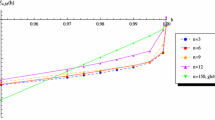Abstract
The paper discusses the approximation of scattered data on the sphere which is one of the major tasks in geomathematics. Starting from the discretization of singular integrals on the sphere the authors devise a simple approximation method that employs locally supported spherical polynomials and does not require equidistributed grids. It is the basis for a hierarchical approximation algorithm using differently scaled basis functions, adaptivity and error control. The method is applied to two examples one of which is a digital terrain model of Australia.
Zusammenfassung
Die Arbeit befaßt sich mit der Approximation ungleichmäßig verteilter Daten (scattered data) auf der Kugel, einer der Hauptaufgabenstellungen der Geomathematik. Ausgehend von der Diskretisierung singulärer Integrale in sphärischer Geometrie beschreiben die Autoren zunächst eine einfaches Approximationsverfahren mit Hilfe von lokalen sphärischen Polynomen, das keine gleichverteilten Daten erfordert. Dieses wird in einem zweiten Schritt durch die Verwendung von skalierten Basisfunktionen zu einem adaptiven Algorithmus mit Fehlerkontrolle ausgebaut. Ein Testbeispiel und die Berechnung eines digitalen Geländemodelles für Australien illustrieren sein Verhalten.
Similar content being viewed by others
References
Berens, H., Butzer, P. L., Pawelke, S.: Limitierungsverfahren von Reihen mehrdimensionaler Kugelfunktionen und deren Saturationsverhalten. Publications of the Research Institute for Mathematical Sciences, Kyoto University, Series A4, 201–268 (1968/69).
Bochner, S.: Positive zonal functions on the sphere. Proc. Natl. Acad. Sci. U.S.A.40, 1141–1147 (1954).
Brand, R.: Approximation using spherical singular integrals and its application to digital terrain modelling. Diploma Thesis, University of Kaiserslautern, Geomathematics Group.
Butzer, P. L., Nessel, R. J.: Fourier analysis and approximation. Vol. 1. One-dimensional theory. Basel: Birkhäuser, 1971.
Calderon, A. P., Zygmund, A.: On a problem of Mihlin. Trans. Amer. Math. Soc.78, 209–224 (1955).
Cui, J., Freeden, W., Witte, B.: Gleichmäßige Approximation mittels Sphärischer Finite Elemente und ihre Anwendung in der Geodäsie. Z Vermessungswesen5, 266–278 (1992).
Ebner, H., Hössler, R., Reinhardt, W.: Generation, management and utilization of high fidelity Digital Terrain Models, Int. Archives of Photogrammetry and Remote Sensing, 27, Part B 11, III/556-III/566 (1988) and HIFI 3.2 Users's Manual, Photogrammetrie GmbH, Muenchen.
Freeden, W.: Spherical spline approximation and its application in physical geodesy. In: Geophysical data inversion methods and applications, (Vogel, A, et al., eds.), pp. 79–104. Proc. of the 7th Math. Geophys. Seminar held at the Free University of Berlin 1989, Braunschweig: Vieweg, 1990.
Freeden, W., Schreiner, M.: Nonorthogonal expansions on the sphere. Math. Meth. Appl. Sci.18, 83–120 (1995).
Freeden, W., Schreiner, M.: New wavelet methods for approximating harmonic functions. IAG Symposia114, (Sanso, F. (ed.)), pp. 112–121. Berlin Heidelberg New York Tokyo: Springer, 1995.
Freeden, W., Windheuser, U.: Spherical wavelet transform and its discretization. Berichte der Arbeitsgruppe Technomatematik, Nr. 125, Kaiserslautern (1994), accepted for publication in Advances in Computational Mathematics
Fröhlich, J., Schneider, K.: An adaptive wavelet Galerkin algorithm for one- and two-dimensional flamme computations. Eur. J. Mech. B/Fluids13, 439–471 (1994).
Gabor, D.: Theory of communications. J. Inst. Elec. Eng.93, 429–457 (1946).
Hoschek, J., Lasser, D.: Grundlagen der geometrischen Datenverarbeitung. Stuttgart: Teubner, 1992.
Kuipers, L., Niederreiter, H.: Uniform distribution of sequences. New York: John Wiley & Sons, 1994.
Monaghan, J. J.: Why particle methods work. SIAM J. Sci. Stat. Comp.3, 422–433 (1982).
Monaghan, J. J.: Smoothed particle hydrodynamics. Annu. Rev. Astron. Astrophys.30, 543–574 (1992).
Niederreiter, H.: Random number generation and quasi-Monte Carlo methods. Philadelphia: SIAM (1992).
Pottmann, H., Eck, M.: Modified multiquadric methods for scattered data interpolation over a sphere, CAGD,7, 313–321 (1990).
Schaffeld, H.-J.: Eine Finite-Elemente-Methode und ihre Anwendung zur Erstellung von Digitalen Geländemodellen. Thesis RWTH Aachen. Veröffentl. Geod. Inst. RWTH Aachen, Nr. 42 (1988).
Samet, H., Webber, R. E.: Hierarchical data structures and algorithms for computer graphics, part I: fundamentals. CG & A8, 48–68 (1988).
Weyl, H.: Über die Gleichverteilung von Zahlen modulo Eins. Math. Ann.77, 313–352 (1916).
Author information
Authors and Affiliations
Rights and permissions
About this article
Cite this article
Brand, R., Freeden, W. & Fröhlich, J. An adaptive hierarchical approximation method on the sphere using axisymmetric locally supported basis functions. Computing 57, 187–212 (1996). https://doi.org/10.1007/BF02247405
Received:
Revised:
Issue Date:
DOI: https://doi.org/10.1007/BF02247405



